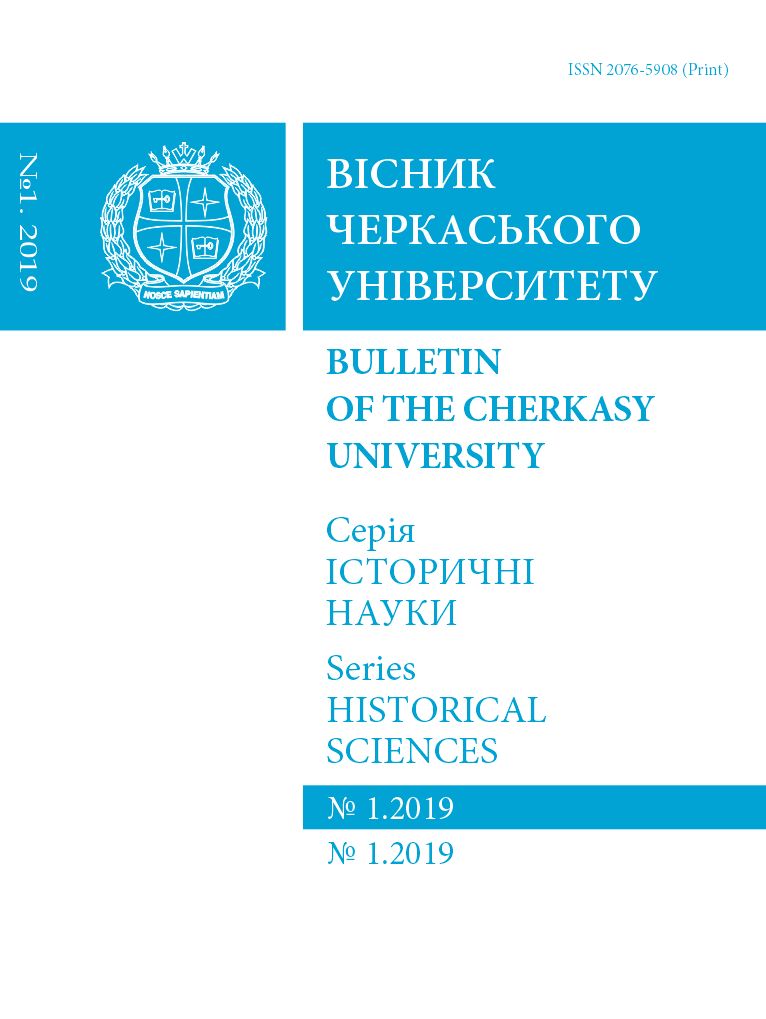Вплив європейського дипломатичного етикету на трансформацію церемоніалу та протоколу в Гетьманщині доби Івана Мазепи
##plugins.themes.bootstrap3.article.main##
Анотація
У статті проаналізовано особливості впливу європейського дипломатичного етикету на трансформацію церемоніалу та протоколу в середовищі козацької старшини у добу гетьманування Івана Мазепи. Звернута увага на особистість гетьмана, дипломатичний протокол та придворний етикет Батуринського двору (прийоми послів), особливості щоденного життя козацької старшини (банкети, бали, одяг тощо). Констатовано, що за гетьманування Івана Мазепи помітно посилилися впливи саме європейського дипломатичного етикету.
##plugins.themes.bootstrap3.article.details##
Посилання
Kasprzak A., Skoropadowa H. Europejskie szklo od XVI do początku XIX wieku w zbiorach Muzeum Etnografii і Przemysіu Artystycznego Instytutu Narodoznawstwa Narodowej Akademii Nauk Ukrainy we Lwowie / A. Kasprzak, H. Skoropadowa // Ministerstwo Kultury і Dziedzictwa Narodowego. Warszawa – 2008. S.130–175.
Sobieski Jakub. Peregrynacja po Europie (1607-1613). Droga do Baden (1638) / Jakub Sobieski / oprac. J. Długosz. – Wrocław, 1991. – 308 s.
Вовк О. Б. Конституція Пилипа Орлика: оригінал та його історія / О. Б. Вовк // Архіви України. – 2010. – Вип. 3–4 (269). – С. 145–166.
Гулієв А. Д. Право зовнішніх зносин: підручник / А. Д. Гулієв. – К. : НАУ. – 2012. – 488 с.
Доба гетьмана Івана Мазепи в документах / Упоряд. С. Павленко. Чернігівський історичний музей ім. В. В. Тарновського; Канадський інститут українських студій Альбертського університету; Інститут рукопису Національної бібліотеки України ім. В. І. Вернадського. – К.: Bид. дiм «Києвo-Мoгилянська академія». – 2007. – 1144 с.
Договори і постанови прав і свобод військових між Ясновельможним Його Милості паном Пилипом Орликом, новообраним гетьманом Війська Запорізького, і між генеральними особами, полковниками і тим же Військом Запорізьким з повною згодою з обох сторін. [Електронний ресурс] – Режим доступу : http: //static.rada.gov.ua/site/const/istoriya/1710.html.
Журавльов Д.В. Мазепа. Людина. Політик. Легенда / Д. В. Журавльов. – Харків: Фоліо. – 2007. – 205 c.
Історія української культури у 5-ти т. Т. 3. / під ред. В. А. Смолія. – К. : Наук. думка. – 2003. – 1246 с.
Крупницький Б. Гетьман Мазепа та його доба / Б. Крупницький. – К.: Україна, 2003. – 240 с.
Нариси з історії дипломатії України / [О. І. Галенко, Є. Є. Камінський, М. В. Кірсенко та ін ; відп. ред. В. А. Смолій]. – К.: Альтернативи. – 2001. – 733 с.
Радишевський Р., Свербигуз В. Іван Мазепа в сарматсько-роксоланському вимірі високого бароко / Р. Радишевський, В. Свербигуз. – К. : Видавничий центр «Просвіта». – 2006. – 551 с.
Саксонское зерцало / Всеобщая история государства и права. – Т. 1. [Електронний ресурс] – Режим доступу : https://history.wikireading.ru/249245
Свербигуз В. Батурин: до генези українського самодержавства / В. Свербигуз. – К. : Видавничий дім «Києво-Могилянська академія». – 2008. – 88 с.
Яворницький Д. Історія запорозьких козаків. У 3-х т. / Д. Яворницький. – К. : Наукова думка. – 1990. – Т. 1. – 583 с.
Яворницький Д. Історія запорозьких козаків. У 3-х т. / Д. Яворницький. – К. : Наукова думка. – 1990. – Т. 2. – 557 с.
Яковенко Н. Дзеркала ідентичності. Дослідження з історії уявлень та ідей в Україні XVI – початку XVIII століття / Н. Яковенко. – К. : Laurus. – 2012. – 472 с.
References
Kasprzak, A., & Skoropadowa, H. (2008). European glass from the 16th to the beginning of the 19th century in the collection of the Museum of Ethnography and Artistic Industry of the Institute of Ethnography of the National Academy of Sciences of Ukraine in Lviv. Ministry of Culture and National Heritage. Warsaw, 130–175 [in Poland].
Sobieski Jakub. (1991). Peregrination around Europe (1607-1613). Droga do Baden (1638). Wroclaw. 308 [in Poland].
Vovk, O.B. (2010). Philip Orlyk’s Constitution: the original and its history. Archives of Ukraine, 3-4 (269), 145–166 [in Ukrainian].
Guliyev A.D. (2012). The right of foreign relations: a textbook. Kyiv: NAU, 488 [in Ukrainian].
Pavlenko, S. (2007). The era of Hetman Ivan Mazepa in the documents. Chernihiv Historical Museum. V.V. Tarnovsky; Canadian Institute of Ukrainian Studies, University of Alberta; Manuscript Institute of the National Library of Ukraine named after V.I. Vernadsky. Kyiv: Kyiv-Mohyla Academy House, 1144 [in Ukrainian].
Treaties and resolutions of the rights and freedoms of the military between His Grace Mr. Philip Orlyk, the newly elected Hetman of the Zaporozhian Army, and between generals, colonels and the same Zaporozhian Army with the full consent of both parties. Retrieved from http://static.rada.gov.ua/site/const/istoriya/1710.html.
Zhuravlyov, D.V. (2007). Blockhead. Man. Politician. Legend Kharkiv: Folio, 205 [in Ukrainian].
Smolya, V.A. (2003). History of Ukrainian culture in 5 vols. Kyiv: Nauk. Opinion, 3,1246 [in Ukrainian].
Krupnytsky, B. (2003). Hetman Mazepa and his time. Kyiv.: Ukraine, 240 [in Ukrainian].
Galenko, O. I., Kaminsky, E.E., Kirsenko, M.V. & Smoliy, V.A. (2001). Essays on the history of diplomacy of Ukraine. Kyiv: Alternatives, 733 [in Ukrainian].
Radyshevsky R., & Sverbyguz, V. (2006). Ivan Mazepa in the Sarmatian-Roksolan dimension of the High Baroque. Kyiv: Publishing Center “Education”, 551 [in Ukrainian].
Saxon mirror. General history of state and law. Volume 1. Retrieved from https://history.wikireading.ru/249245 [in Russian].
Sverbyguz, V. (2008). Baturyn: to the genesis of the Ukrainian autocracy. Kyiv: Publishing House “Kyiv-Mohyla Academy”, 88 [in Ukrainian].
Yavornytsky, D. (1990). History of the Zaporozhian Cossacks. In 3 vols. Vol. 1. Kyiv: Nauk. Opinion, 583 [in Ukrainian].
Yavornytsky, D. (1990). History of the Zaporozhian Cossacks In three volumes. Vol. 2. Kyiv: Nauk. Opinion, 557 [in Ukrainian].
Yakovenko, N. (2012). Mirrors of identity. Research on the history of ideas in Ukraine in the XVI - early XVIII centuries. Kyiv: Laurus, 472 [in Ukrainian].

